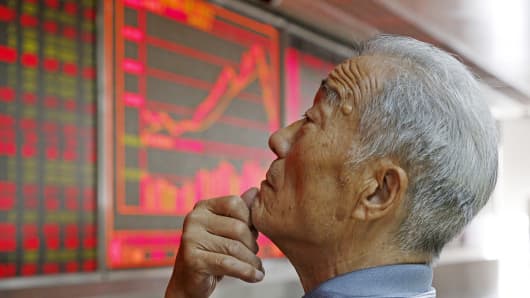Intermediate-term oversold conditions are becoming widespread globally for the first time in months, and in some cases years. The term "oversold" means that supply has saturated the market, and is likely close to the point of being fully absorbed. In Hong Kong, oversold conditions are currently being enhanced by counter-trend signals in indicators that identify inflection points marking the end of existing trends. This tells us that it is probably only a matter of weeks before demand takes hold again in China and beyond.
Read More Why China is dangerous for investors
Importantly, long-term uptrends remain intact in both the Shanghai composite index and Hong Kong's Hang Seng index despite recent weakness. This is a function of the steep rally that preceded the correction. The charts don't identify the driving forces behind the rally, but they can help us discern when and where buyers are likely to step back into Chinese stocks. Potential areas of buying pressure are described as support, and China's benchmarks have potentially strong support not far from current levels.
For one, the Shanghai composite index is testing its widely watched 200-day moving average, which is trending higher in a reflection of the long-term uptrend. Thursday's intraday reversal has the potential to give way to a successful test of the 200-day moving average, which often acts as a cushion for price. Dips below the 200-day moving average are often met with buyers, as was the case for the S&P 500 index in October 2014. Not accidentally, tests of the 200-day moving average usually go hand in hand with a surge in bearish sentiment, which creates a ripe environment for shakeouts, or false breakdowns.
Read MoreOp-ed: China's handling its market all wrong
The Hang Seng index has already penetrated its 200-day moving average, but has retreated to a zone of support defined by a popular trend-following gauge called Ichimoku Kinko Hyo, a Japanese indicator that is colloquially known as the cloud model and tends to hold particular relevance for Asian markets. In addition, the Hang Seng index is approaching an important retracement level derived from mathematician Leonardo Fibonacci's famous numerical sequence. With twofold support nearby, the Hang Seng index appears even closer to an important low than the Shanghai composite index, forwarded by its perception as a less-risky way to invest in China.
While there is undeniable risk surrounding the outlook for Chinese stocks, the potential reward is also high from a technical standpoint. Once confidence is restored to the market, whether driven by government action or other forces, there is significant upside to the nearest resistance on the charts. With hindsight we can see that corrections, as painful as they are, contribute to the sustainability of uptrends because they compel investors to add exposure when the risk/reward outlook appears favorable. For those who believe in the long-term prospects for China, oversold conditions and the proximity of support should be viewed as such an opportunity.
Read MoreIf China loses control, look out oil: Dan Yergin
Commentary by Katie Stockton, chief technical strategist—research, BTIG. Follow her on Twitter @StocktonKatie


